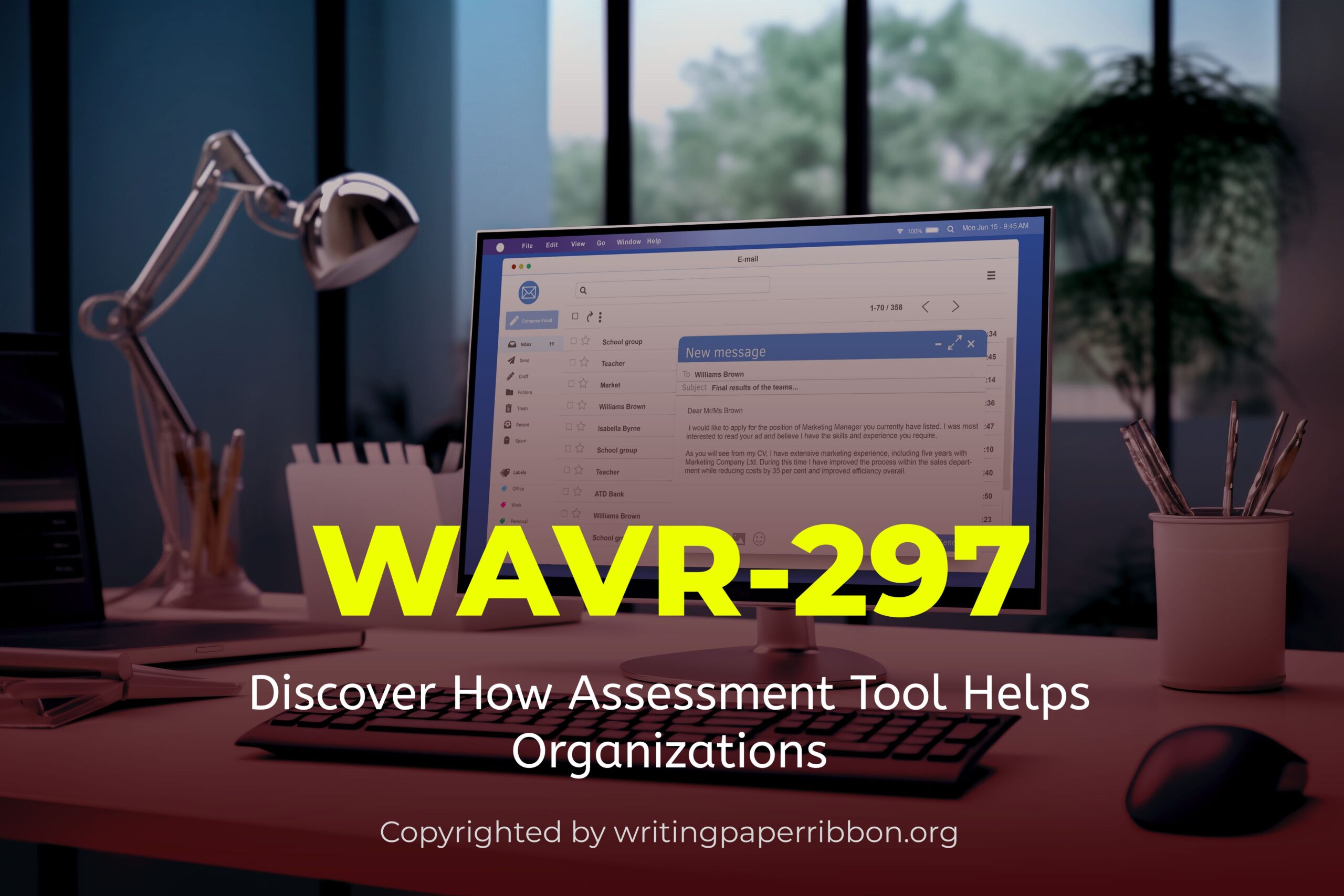WAVR-297: Discover How Assessment Tool Helps Organizations
What is WAVR-297 and its significance?
WAVR-297, short for Workplace Assessment of Violence Risk, is an assessment tool designed to evaluate the risk of violence in workplace settings. Developed by Dr. Stephen G. White and Dr. Reid Meloy, WAVR-297 provides a structured approach for assessing potential threats and managing risks associated with workplace violence. Its significance lies in its systematic methodology, which helps organizations identify, evaluate, and mitigate potential threats, ensuring a safer work environment.

Table of Contents
Key Features of WAVR-297
Structured Assessment: WAVR-297 uses a structured framework comprising 21 risk factors to evaluate the potential for violence. These factors are based on empirical research and expert consensus.
Behavioral Indicators: The tool focuses on behavioral indicators rather than relying solely on psychological diagnoses, making it applicable to diverse workplace scenarios.
Dynamic and Static Factors: It considers both dynamic (changeable) and static (unchangeable) factors, offering a comprehensive risk profile.
Case Management Guidance: WAVR-297 provides guidelines for managing cases of potential violence, including intervention strategies and follow-up procedures.
Scoring System: The assessment includes a scoring system that quantifies the level of risk, aiding in decision-making processes.
Why is WAVR-297 Important?
Proactive Risk Management: By identifying potential threats early, organizations can take proactive measures to prevent incidents.
Legal and Ethical Compliance: Using WAVR-297 can help organizations meet legal and ethical obligations to provide a safe workplace.
Resource Allocation: It aids in prioritizing resources for intervention based on the assessed level of risk.
Enhanced Communication: The structured approach facilitates clear communication among stakeholders, including HR, security, and mental health professionals.
How does the WAVR-297 assessment process work?

The WAVR-297 assessment process involves several steps designed to systematically evaluate the risk of workplace violence. Here’s a detailed look at how the process works:
Step-by-Step Assessment Process
Initial Referral: A potential threat is identified and referred to the threat assessment team.
Preliminary Screening: The team conducts an initial screening to determine if a full assessment is warranted.
Data Collection: Comprehensive data is gathered from various sources, including interviews, observations, and document reviews.
Risk Factor Analysis: The 21 risk factors of WAVR-297 are analyzed, with each factor rated based on its relevance and severity.
Scoring and Interpretation: The ratings are compiled into a total score, which helps in interpreting the overall risk level.
Developing an Intervention Plan: Based on the assessment, an intervention plan is developed, outlining specific actions to mitigate the identified risks.
Implementation and Monitoring: The intervention plan is implemented, and ongoing monitoring is conducted to assess its effectiveness.
Reassessment: Periodic reassessments are conducted to ensure that the risk level remains manageable and that the intervention plan is still appropriate.
Data Collection Methods
- Interviews: Conducting interviews with the subject, coworkers, and other relevant individuals to gather insights into behavior and context.
- Observations: Observing the subject’s behavior in different settings to identify any concerning patterns.
- Document Review: Reviewing documents such as personnel files, incident reports, and medical records to gather relevant information.
Scoring System
The WAVR-297 scoring system involves rating each of the 21 risk factors on a scale from 0 to 4, where 0 indicates no concern and 4 indicates a high level of concern. The total score provides an overall risk level, guiding the threat assessment team in decision-making.
Importance of a Multidisciplinary Approach
A multidisciplinary approach is crucial in the WAVR-297 assessment process. Involving professionals from HR, security, legal, and mental health fields ensures a comprehensive evaluation and effective intervention strategies.
What are the 21 risk factors in WAVR-297?

The WAVR-297 framework includes 21 risk factors that are essential for assessing the potential for workplace violence. These factors are categorized into individual, contextual, and situational elements.
Individual Risk Factors
History of Violence: Past violent behavior is a strong predictor of future violence.
Threats of Harm: Verbal or written threats can indicate an increased risk of violence.
Intense Emotions: High levels of anger, frustration, or resentment may contribute to violent tendencies.
Paranoia or Delusional Thoughts: Paranoid or delusional thinking can increase the likelihood of violent actions.
Substance Abuse: Alcohol or drug abuse can impair judgment and increase aggression.
Contextual Risk Factors
Job Loss or Significant Stressors: Recent job loss or major life stressors can trigger violent behavior.
Conflict with Coworkers: Ongoing conflicts or interpersonal issues at work may escalate to violence.
Access to Weapons: Easy access to weapons increases the potential for violent incidents.
Recent Legal Issues: Legal troubles can contribute to stress and aggressive behavior.
Psychological Conditions: Certain psychological conditions may predispose individuals to violence.
Situational Risk Factors
Organizational Change: Major changes in the workplace, such as restructuring, can increase stress and the risk of violence.
Poor Work Performance: Chronic poor performance and associated reprimands can escalate tensions.
Isolation: Social isolation at work can contribute to feelings of resentment and aggression.
Hostile Work Environment: A toxic or hostile work environment can increase the likelihood of violent behavior.
Negative Attitudes Toward Management: Disdain or mistrust of management can be a risk factor.
Additional Factors
Inconsistent Enforcement of Policies: Lack of consistent policy enforcement can lead to feelings of unfair treatment.
Signs of Pre-attack Planning: Evidence of planning an attack, such as detailed notes or reconnaissance, is a serious concern.
Disciplinary Actions: Recent disciplinary actions may provoke retaliatory behavior.
Mental Health Treatment: Lack of appropriate mental health treatment can exacerbate risk.
Support Systems: Weak social or familial support can increase vulnerability to stress.
Overall Risk Context: The overall context, including any combination of the above factors, should be considered.
Application of Risk Factors
Each of these risk factors is rated during the assessment process, providing a comprehensive view of the potential for workplace violence. The combination of these factors helps threat assessment teams develop effective intervention strategies.
How can organizations implement WAVR-297?

Implementing WAVR-297 in an organization involves several key steps to ensure its effectiveness in preventing workplace violence. Here’s a guide on how organizations can successfully integrate WAVR-297 into their safety protocols.
Steps for Implementation
Establish a Threat Assessment Team: Form a multidisciplinary team comprising HR, security, legal, and mental health professionals.
Training and Education: Provide comprehensive training for the threat assessment team on using WAVR-297, including understanding the 21 risk factors and the scoring system.
Develop Policies and Procedures: Create clear policies and procedures for identifying, assessing, and managing potential threats. Ensure these are communicated to all employees.
Promote Awareness: Educate employees about the importance of reporting potential threats and the procedures in place for handling such reports.
Data Collection Protocols: Establish protocols for collecting and documenting information related to potential threats, including interviews, observations, and document reviews.
Conduct Regular Assessments: Regularly use WAVR-297 to assess identified threats and reassess them as needed to ensure ongoing safety.
Intervention Planning: Develop and implement intervention plans based on assessment results, including specific actions to mitigate risks.
Monitor and Reassess: Continuously monitor the effectiveness of intervention plans and reassess risk levels periodically.
Feedback Mechanisms: Implement feedback mechanisms to refine and improve the threat assessment process.
Compliance and Review: Ensure compliance with legal and ethical standards and conduct periodic reviews of the WAVR-297 implementation process.
Challenges and Solutions
Resistance to Change: Overcome resistance by demonstrating the benefits of WAVR-297 and involving employees in the implementation process.
Resource Allocation: Allocate adequate resources, including time and personnel, to ensure thorough assessments and effective interventions.
Maintaining Confidentiality: Ensure confidentiality of all assessments and interventions to protect the privacy of individuals involved.
Benefits of Implementation
Enhanced Safety: Proactively managing threats reduces the risk of violent incidents.
Improved Workplace Culture: A structured approach to threat assessment promotes a culture of safety and well-being.
Compliance: Adopting WAVR-297 helps organizations comply with legal and regulatory requirements regarding workplace safety.
What are the training requirements for using WAVR-297?

Training is a critical component for the effective use of WAVR-297. Proper training ensures that the threat assessment team can accurately assess risks and develop appropriate intervention strategies.
Core Training Components
Understanding WAVR-297: Training on the fundamentals of WAVR-297, including its development, purpose, and key features.
Risk Factor Analysis: Detailed instruction on the 21 risk factors, including how to rate and interpret each factor.
Data Collection Techniques: Guidance on conducting interviews, observations, and document reviews to gather relevant information for assessment purposes.
Scoring System: Training on how to use the scoring system to calculate total risk scores and interpret the results.
Case Management: Instruction on developing intervention plans based on assessment findings and managing cases of potential violence.
Legal and Ethical Considerations: Education on the legal and ethical obligations surrounding threat assessment and management, including confidentiality and privacy laws.
Simulation Exercises: Hands-on practice through simulated scenarios to apply knowledge and skills in real-life situations.
Continuous Learning: Ongoing training to stay updated on new developments in threat assessment research and best practices.
Training Delivery Methods
In-Person Workshops: Conduct interactive workshops led by experienced trainers to facilitate learning and skill development.
Online Courses: Offer self-paced online courses with modules covering various aspects of WAVR-297 training.
Webinars and Seminars: Host webinars and seminars featuring expert speakers to provide in-depth insights into threat assessment and management.
On-the-Job Training: Provide on-the-job training opportunities where team members shadow experienced assessors and participate in live assessments.
Certification Programs: Establish certification programs for individuals who have completed comprehensive training and demonstrated proficiency in using WAVR-297.
Training Providers
Certified Trainers: Seek training from certified trainers who have expertise in threat assessment and management, preferably those with experience using WAVR-297.
Professional Associations: Look for training programs endorsed or offered by professional associations specializing in workplace safety and security.
Consulting Firms: Engage consulting firms that specialize in threat assessment and offer customized training programs tailored to organizational needs.
Online Platforms: Explore online platforms that offer accredited courses and resources for threat assessment training, including modules specifically on WAVR-297.
Evaluation and Feedback
Assessment of Learning: Conduct assessments to evaluate participants’ understanding and application of WAVR-297 concepts and skills.
Participant Feedback: Gather feedback from participants to identify strengths and areas for improvement in the training program.
Continuous Improvement: Use feedback to refine training materials and delivery methods to enhance effectiveness and relevance.
Importance of Ongoing Training
Continuous training and professional development are essential for maintaining proficiency in threat assessment and management. Regular updates and refresher courses ensure that the threat assessment team stays informed about the latest research findings and best practices, thereby enhancing the organization’s ability to prevent and respond to workplace violence effectively.
How can WAVR-297 contribute to a safer work environment?

WAVR-297 plays a crucial role in creating and maintaining a safer work environment by providing organizations with a structured framework for identifying, assessing, and managing potential threats of violence. Here’s how WAVR-297 contributes to promoting workplace safety:
Early Identification of Risks
- By systematically evaluating various risk factors, WAVR-297 helps organizations identify potential threats at an early stage, allowing for proactive intervention before incidents occur.
- Early identification enables timely implementation of preventive measures, such as counseling, mediation, or security measures, to mitigate the risk of violence.
Comprehensive Risk Assessment
- WAVR-297 offers a comprehensive approach to risk assessment by considering a wide range of individual, contextual, and situational factors that may contribute to workplace violence.
- The structured assessment process ensures that no relevant risk factors are overlooked, providing a thorough understanding of the potential for violence in a given situation.
Tailored Intervention Strategies
- Based on the assessment results, WAVR-297 enables organizations to develop tailored intervention strategies that address the specific risk factors identified.
- Intervention plans may include measures such as conflict resolution techniques, employee support programs, or security enhancements, depending on the nature and severity of the risks.
Collaboration and Coordination
- WAVR-297 promotes collaboration and coordination among different stakeholders, including HR, security, legal, and mental health professionals, in addressing workplace violence.
- A multidisciplinary approach ensures that interventions are holistic and well-coordinated, maximizing their effectiveness in mitigating risks and enhancing workplace safety.
Compliance with Legal and Ethical Standards
- By using WAVR-297, organizations demonstrate a commitment to fulfilling their legal and ethical obligations to provide a safe and secure work environment for employees.
- Compliance with established threat assessment protocols and procedures helps mitigate legal risks and liabilities associated with workplace violence incidents.
Cultivating a Culture of Safety
- Implementing WAVR-297 fosters a culture of safety and well-being within the organization by promoting awareness of potential threats and the importance of proactive risk management.
- Employees feel reassured knowing that their safety is a priority for the organization, which can lead to increased morale, productivity, and retention.
Continuous Improvement
- WAVR-297 supports continuous improvement efforts by providing a structured framework for evaluating the effectiveness of interventions and refining threat assessment processes over time.
- Regular reassessments and reviews ensure that risk management strategies remain adaptive and responsive to changing circumstances and emerging threats.
Can WAVR-297 be used in different industries?

Yes, WAVR-297 can be adapted for use in various industries and workplace settings where the risk of violence may be a concern. While it was initially developed with a focus on assessing threats in healthcare settings, its principles and methodologies can be applied across different sectors. Here are some examples of industries where WAVR-297 may be used:
Healthcare
- Hospitals, clinics, and medical facilities face unique challenges related to workplace violence, including patient aggression, visitor incidents, and staff conflicts.
- WAVR-297 can help healthcare organizations assess and manage these risks, ensuring the safety of patients, staff, and visitors.
Education
- Schools, colleges, and universities may encounter threats of violence from students, staff, or external individuals, posing risks to the school community.
- WAVR-297 can assist educational institutions in evaluating and addressing potential threats, implementing preventive measures, and supporting students’ mental health needs.
Corporate
- Corporate workplaces, including office environments, manufacturing facilities, and corporate headquarters, may experience violence related to interpersonal conflicts, layoffs, or disgruntled employees.
- WAVR-297 provides corporate entities with a structured approach to risk assessment and management, helping them create a safe and secure work environment for employees.
Government
- Government agencies and departments, such as law enforcement, social services, and regulatory bodies, may encounter threats from clients, constituents, or external parties.
- WAVR-297 can support government organizations in assessing and mitigating risks, enhancing the safety and security of employees and the public.
Retail and Hospitality
- Retail stores, restaurants, hotels, and other customer-facing businesses may face threats from disgruntled customers, shoplifters, or employees.
- WAVR-297 can assist retail and hospitality industries in identifying potential risks, implementing security measures, and training staff to respond effectively to incidents.
Entertainment and Events
- Entertainment venues, event spaces, and stadiums may be susceptible to violence during concerts, sporting events, or large gatherings.
- WAVR-297 can help event organizers and venue operators assess security risks, develop emergency response plans, and coordinate with local authorities to ensure public safety.
Transportation and Logistics
- Transportation companies, including airlines, railways, and trucking companies, may encounter violence from passengers, employees, or external threats.
- WAVR-297 can support transportation and logistics industries in assessing risks, implementing security protocols, and providing training to personnel to prevent and manage incidents.
Conclusion
WAVR-297 offers a comprehensive approach to assessing and managing workplace violence across diverse industries. By identifying potential threats early and implementing tailored intervention strategies, organizations can create safer work environments, promote a culture of safety, and comply with legal and ethical standards. Through continuous training, collaboration, and improvement, WAVR-297 empowers organizations to mitigate risks and protect their employees, customers, and stakeholders effectively.
If you found our content helpful don’t forget to share it on your social media: Twitter
More Articles: Home





